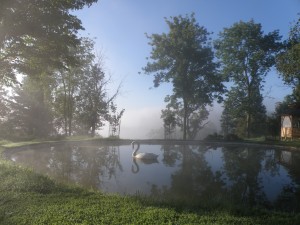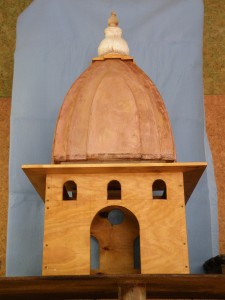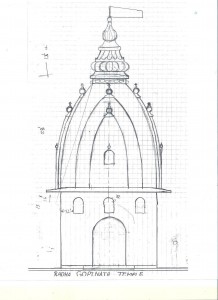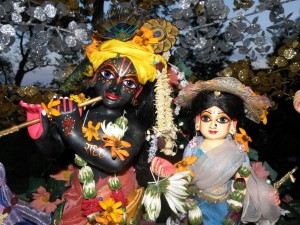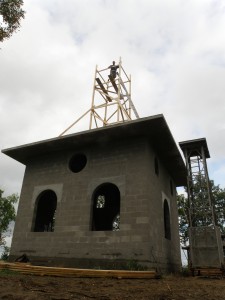“Modest Elegance”- An Interview with New Vrindaban’s Varsana Swami
“Modest Elegance” – An Interview with Varsana Maharaj
INTERVIEWER: Please describe your project to us, Maharaj.
VARSANA M: Our Govardhana Hill project, featuring Radha Kunda and Syama Kunda as central landscape features, Radha Gopinath as the resident deity, and Their temple as the prime focus, derives inspiration and direction from a consistent thread interwoven through the fabric of Srila Prabhupada’s instructions, vision, and desire for New Vrindaban.
Srila Prabhupada’s vision for New Vrindaban includes five main topics, one of which is holy pilgrimage. New Vrindaban is, of course, an ongoing and very important place of holy pilgrimage for many devotees and pilgrims all over the world. In addition, Srila Prabhupada had a specific vision, which we will discuss shortly, for exactly what he wanted to see in New Vrindaban as a place of pilgrimage, and that is what I am basing my project on. I was surprised to learn that many devotees were NOT aware that the “Seven temple on seven hills” concept was exclusively Srila Prabhupada’s idea! This explained to me why we weren’t attracting much support or participation for this first of the seven temples.
As a point of reference, and framework for understanding, consider Srila Prabhupada’s response to news of the potential for land in Appalachia. His response revealed an endearing aspect of his personality which is not readily apparent. He said something wonderful – “I have a fancy for your country,” he told Hayagriva, in his letter written from his residence at the Radha Damodara Mandir.
This was in 1968, the very first letter that Hayagriva received from Srila Prabhupada in India.
Srila Prabhupada went on: “I have a fancy for your country. And being inspired by that fancy, I went there first. Now, Krsna is blessing a nice piece of land which resembles Vrindaban, to be a new place of pilgrimage for you western devotees. If turned into New Vrindaban, I shall forget to return to India!”
And later, “Now I’m trying to return to the United States as soon as possible.”
These words of Srila Prabhupada are both very clear and revealing.
Later that same year, Srila Prabhupada wrote again to Hayagriva.
“Because I’m getting older, and if any time you take me to your new hermitage, I will be glad to go there, and finish my life translating Srimad Bhagavatam and the Goswamis’ literatures.”
<<>>
INTERVIEWER: Wow. There are probably a lot of devotees who were not aware of these letters.
VARSANA M: There is more! That same year, 1968, Kirtanananda and Hayagriva went to Montreal to see Srila Prabhupada. They explained to him that New Vrindaban has long roads and is quite hilly. Srila Prabhupada replied that it is better to use horse and wagon than jeep. Then he became very specific.
“All the hills and temples should be named after the goswamis’ temples in Vrindaban.” Then Srila Prabhupada’s eyes became wide with the anticipation of seeing these temples manifest. He went on, ““Rename the hills Govardhan. If there are lakes, name them Syama Kunda and Radha Kunda.” “Vrindaban is a transcendental village completely dependent on nature’s beauty and protection. Therefore dedicate yourselves to plain living and high thinking.”
These ideas are what I base my project on. Of course, I, personally, have no money or manpower, but this project is definitely taking on a life of its own and receiving support from our family of devotees.”
<<>>
INTERVIEWER: Why Radha Kunda and Syama Kunda? Why does Srila Prabhupada say it’s important to name the lakes Radha Kunda and Syama Kunda, after the original lakes in Braja?
VARSANA M: The answer is both profound and practical. When Lord Gauranga went to Vrindaban, He asked “Where is Radha Kunda? Where is Syama Kunda?” He saw these sacred ponds as crucial to His mission.
The waters of Radha Kunda infuse the soul with a love for Krsna similar to Radha’s, and, similarly, the waters of Syama Kunda infuse the soul with love of Radha similar to what Krsna feels for Her.
Lord Gauranga and Srila Prabhupda know that these kundas are instrumental in perfecting our chanting. The acaryas tell us that having access to these ponds is very significant in developing a taste for the holy name. It’s not just abstract. It’s very concrete in developing our love for Krsna through hearing and chanting.
These are very humble beginnings. Eventually, it will be a demonstration of modest elegance.
<<>>
INTERVIEWER: Maharaja, please tell us a bit about the Temple building itself.
VARSANA M: The temple itself will be 50 feet high with a dome on top. The temple is being fashioned, in a simpler way, after Madhu Pandit’s first and original Radha Gopinath Mandir in Vrindaban, before it was desecrated by marauding Moghul iconoclasts.
The community celebrated Radhastami in 2012 inside the walls of the new Radha Gopinath temple, as we revealed completion of the first phase of construction, and this was the turning point, when it became acceptable in people’s eyes.
To honor Srila Prabhupada’s words, desire, and vision, it is crucial that my generation complete at least the first of the seven temples that Srila Prabhupda wanted for New Vrindaban, in our lifetime.
Everything here is arranged according to the terrestrial features of the original Vrindaban.
This model that you see is for design purposes only. We do not have 3-D CAD (Computer Aided Design) ability on our computers, so this is not exactly what the finished temple will look like. This is a model of the basic shape and design of the temple. Many more embellishments will adorn the outside of the temple.
<<>>
INTERVIEWER: We know that Josef has been doing a great job guiding parikrama parties from the temple to the Radha Gopinath Hill here. Can you elaborate on that aspect?
VARSANA M: Yes, he certainly has. But he needs some place markers and written stories. And he needs signs which mark the way, in order to execute the parikrama following the proper protocol, which is as follows, just as it is in Vrindaban.
You begin at Kusum Sarovara (swan lake) at the foot of Govardhan Hill, then you pass the big Gaura Nitai statues, Who are inviting and blessing pilgrims to follow Their footsteps.
Then you come to Manasa Ganga, a small version of which we excavated this year. The parikrama path curves up the hill, where you go to Lalita Kunda, then to the rock temple of Kundesvara Mahadeva Siva, and finally to the Gopinathji temple.
The central features are Radha Kunda, with its guardian swan floating upon Her waters; next is Syama Kunda, which is surrounded by the kundas of the sakhas, of which Sridama Kunda is already manifest.
There are smaller parikrama paths within the larger one. They all end at the Gopinath Mandir.
You can also turn onto the path to Prabhupada’s Palace if you’d like, which, spiritually, brings everything full circle. These are some of the many options depending on the time you have, the weather, if you’re in a wheelchair, etc.
<<>>
INTERVIEWER: I know there are people who would love to help with this project. How can they do that?
VARSANA M: We need signs that describe each place on the paths, as well as direction signs to clearly point out the different parikrama paths.
I’ve already written up many meditations for each of the holy places for which we need volunteers with literary and computer skills to accomplish the task of publishing, laminating and posting all of these stories.
All the material is there; it just needs to be coordinated. There are people already working on this who could use help.
As far as physical help, there are plenty of landscape opportunities.
So the modest elegance of the Radha Gopinath project has reached the stage of being appreciated. The larger aspiration is encouraging people to appreciate New Vrindaban in general.
<<>>
INTERVIEWER: Why did you choose this particular design for the temple? Can you please give us some kind of historical perspective on that?
VARSANA M: The design closely resembles the original Radha Gopinath Mandir inspired by Madhu Pandit, who is entrusted with the care of the original Radha Gopinath deities, who were installed by Vajranabha, Krsna’s great grandson!
His sponsor was Rayasila Shekhavata who was granted land by Akbar in appreciation of his defeating the Afghans.
It is commonly accepted that Radha Gopinath Mandir was built before Madan Mohan and Radha Govinda temples.
<<>>
INTERVIEWER: Some people have asked if you know whatever happened to the same Ananta Sesa who was installed in the cornerstone of the Govindaji Temple.
VARSANA M: There’s a story behind that one! Ananta Sesa, who rests in the N.E. cornerstone of this temple, was first installed in 1973 for the foundation of the Govinda temple, which was never built. The cornerstone was relocated to the Temple of Understanding, which was also never built. At last the cornerstone ended up here, where, one day, in the middle of a Kartik lecture, I saw Ananta Sesa looking out from a hole which had developed in the cornerstone over time. I took this as a sign that He needed and wanted to take up the rightful position in the footer of a temple that would be built upon His hoods, which uphold the entire creation, after 39 years of living within a cornerstone that was repeated being moved!
<<>>
INTERVIEWER: So THAT’S where Ananta Sesa ended up! Ecstatic! There are a lot of exciting things going on up at your place, I see. Maharaja, is there anything else you’d like to say about the Radha Gopinath Mandir project?
VARSANA M: For Srila Prabhupada, the jagat guru, spiritual master of the universe, home means Vrindaban – nowhere else. And that is what constitutes the Holy Dhama – the presence of the acarya who carries Krsna in his heart and can thus install Him anywhere.
It is not our own endeavors to build temples, excavate kundas, and rename tracts of land according to their facsimiles in Vraja. It is the presence of Srila Prabhupada that makes this place, in his own words, “non-different from Vrindaban.”
Srila Prabhupada affirmed that he had indeed taken up residence in the Palace, which is his Samadhi, where sincere sadhakas can take up and develop their ongoing relationship of service with him.
Our Govardhana Hill project and the Radha Gopinath temple are for the purpose of complimenting the Palace grounds according to Srila Prabhupada’s vision, a replica of Vrindaban, to assure his pleasure of feeling at home.
